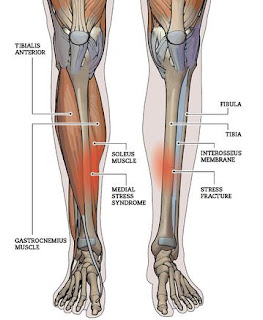Shin splints are among the most frequent injuries to sideline runners—especially those who are just starting out or returning to the sport after a long layoff. But runners aren’t the only ones to feel the pain. Any activity that involves jumping (think: plyometrics, HIIT workouts, CrossFit, etc.) can cause shin splints. Here’s what’s really happening and how to keep your legs feeling strong and healthy.
What’s a Shin Splint?
“Shin splints usually occur following repetitive trauma to the connective muscle tissue surrounding the tibia, or shinbone,” says John Gallucci Jr., D.P.T., president of JAG Physical Therapy in New Jersey. “This muscle breaks down and becomes inflamed. During the healing process, it forms scar tissue where one of the calf muscles adheres to the tibia, causing pain and tightness.”
What Do Shin Splints Feel Like?
If you are experiencing a dull, achy pain on the inside or front of your shin that worsens with activity after a warm up or lingers after a workout, you may have shin splints. In more severe cases, the dull pain may start to feel like a stabbing sensation.
Why Do Shin Splints Happen?
The majority of people get shin splints on the inside of the shin. “The job of the posterior tibialis [the muscle immediately behind the shin] is to slow down the twist of the foot while running, walking, and cutting,” explains Jay Dicharry, a physical therapist and author of Anatomy for Runners. But when the muscles in the feet are weak, a higher load of force is placed on the muscles in the shin. “Essentially, you are asking these muscles to do too much work, and they begin to break down.” About a third of patients, however, will feel pain in the front of the shin. “Under normal circumstances, the foot acts as a shock-absorbing spring. But when the foot is excessively stiff, it passes the increased stress upward, which overloads the muscles along the front of the shin,” says Dicharry.
You’re also more susceptible to shin splints if you have flat feet. “Fallen arches, or an overpronation of the foot, cause added stress and pain along the inside of your shin bones,” adds Gallucci.
How Can I Prevent Shin Splints?
Start slow: Most people develop shin splints from jumping into a new routine without first preparing their muscles and joints for the added work. “Shin splints can present in athletes who don’t gradually progress their mileage or who abruptly change the surface they’re working out on, such as switching from running on dirt to concrete,” says Gallucci. Switching up your route can also help. “Roads are generally cambered, or arched, with one side a little higher. This helps with water drainage, but it also means you’re placing more stress on one leg or hip,” he notes.
Keep your shoes current: “Running shoes are designed to last about 300 to 400 miles before they should be discarded. Running on worn shoes places more stress on the lower leg and hips because they have less shock absorbency,” warns Gallucci.
What’s the Best Way to Treat Shin Splints?
Take a break from activity and ice your leg several times a day to help reduce muscle inflammation. Try using ice cups: Freeze water in a small (4-to 6-ounce) paper cup, then tear the paper off the top and massage in a circular pattern over the area for five minutes at a time. “This will aid in breaking up the painful adhesions and reduce inflammation,” says Gallucci.
Cross-train with cycling or swimming as well as strength moves and stretching. If the injury still hasn’t gotten better in a couple of weeks, it may be time to seek medical attention, since you may have developed a stress fracture. The good news, says Gallucci, is that when shin splints are treated correctly, they shouldn’t keep you sidelined for very long. “Early recognition will lead to a relatively short recovery period,” he says. “But if treatment is delayed and a stress fracture or full fracture develops, you could be out of commission for much longer.”
For more, check out our guide to four basic stretches that help prevent shin splints.
Leave your comment below.Click Here For More Articles
Don't forget to optin to Our Healthy Living Society, for the latest information on health, wellbeing and groundbreaking news about natural nutrition.


No comments:
Post a Comment